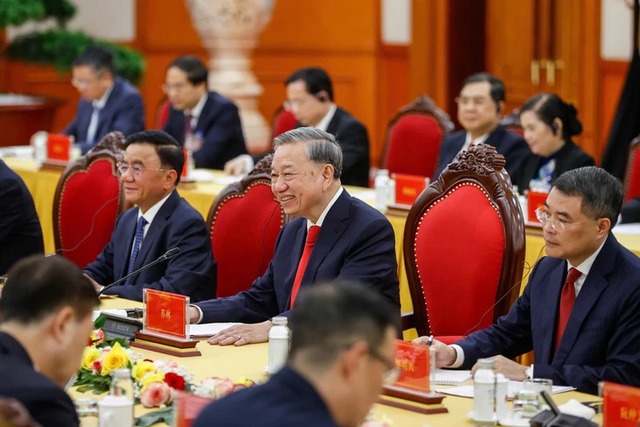
China gives priority to Vietnam in neighborhood diplomacy: Xi Jinping
Chinese Party General Secretary and President Xi Jinping affirmed that China considers Vietnam a top priority in its neighboring diplomacy, supports its prosperity and people’s well-being, and seeks to deepen all-round cooperation during his state visit to Vietnam.
At the invitation of Party General Secretary To Lam and State President Luong Cuong, Xi's two-day visit, which began on Monday, marks a significant milestone as the two countries commemorate 75 years of diplomatic relations.
During his talks with Xi in Hanoi on the same day, General Secretary Lam highlighted the importance of the visit, expressing confidence that it would open a new chapter in the enduring friendship between the two Parties and nations.
Lam emphasized that strengthening ties with China remains an objective requirement, a strategic choice, and a top priority in Vietnam’s foreign policy.
Chinese leader Xi expressed delight at returning to Vietnam – calling it ‘both a comrade and a brother’ – and said choosing Vietnam as the first stop in his overseas visits this year reflects China’s high regard for bilateral relations and the deep bonds between the two nations.
He reiterated China’s unwavering policy of friendship with Vietnam, highlighted the priority it gives to bilateral ties in neighborhood diplomacy, and reaffirmed support for Vietnam’s prosperity and the well-being of its people.
Xi also expressed readiness to work closely with General Secretary Lam and other key Vietnamese leaders to shape a shared vision for building a China-Vietnam community with a shared future holding strategic significance.

Party General Secretary To Lam (C) speaks during a meeting with Chinese Party General Secretary and President Xi Jinping in Hanoi, April 14, 2025. Photo: Hai Pham / Tuoi Tre
The two leaders discussed enhancing strategic trust, promoting high-level exchanges, and strengthening cooperation between the two Parties in diplomacy, defense, and security.
They also agreed to establish a Joint Railway Cooperation Committee between the two governments to boost railway cooperation.
General Secretary Lam proposed upgrading dialogue mechanisms to the ministerial level and boosting connectivity through strategic infrastructure projects.
He specifically called for China’s support in providing concessional loans, transferring technology, and training human resources to ensure progress on key initiatives such as the Lao Cai-Hanoi-Hai Phong railway.
He also proposed advancing digital transformation, scientific and technological cooperation, and key technologies as a new highlight in bilateral ties.
The Vietnamese leader urged both sides to promote more balanced trade and higher-quality investments, especially in large-scale, flagship projects that address issues like air pollution in major cities such as Hanoi.
He also stressed the importance of strengthening educational collaboration, particularly in training high-quality human resources in fundamental sciences and emerging high-tech sectors.
The Chinese leader welcomed Lam’s proposals and agreed on deepening strategic trust, enriching socialist theory and practice, and fostering stronger production and supply chains.
Xi emphasized linking China’s Belt and Road Initiative with Vietnam’s 'Two Corridors, One Belt' framework and encouraged more Vietnamese exports to China and greater Chinese investment in Vietnam.
He also suggested expanding high-tech cooperation in fields such as 5G, AI, IoT, semiconductors, and green development, with a focus on turning scientific innovation into real productivity.
On people-to-people exchanges, the Chinese leader proposed organizing diverse and engaging activities to deepen mutual understanding and friendship.
He announced that over the next three years, China would invite Vietnamese youth to join a ‘red journey’ to explore the revolutionary histories of both countries.
Both leaders agreed to enhance coordination in multilateral forums, including judicial and law enforcement cooperation under the Lancang-Mekong framework.
They also pledged to manage differences appropriately and promote cooperation aligned with international law and the elevated status of Vietnam-China relations.
They reaffirmed their commitment to fully implementing the Declaration on the Conduct of Parties in the East Vietnam Sea (DOC) and advancing a substantive, effective Code of Conduct (COC) in the same waters, in line with international law and the 1982 United Nations Convention on the Law of the Sea (UNCLOS).
Following the talks, the two leaders witnessed the signing of 45 cooperation documents across various sectors by ministries, agencies, and localities of both countries, underscoring the visit’s comprehensive and fruitful outcomes.
Vietnam and China established diplomatic ties in January 1950 and upgraded their relationship to a comprehensive strategic partnership in May 2008.
Currently, Vietnam is China's largest trading partner in ASEAN and ranks fifth worldwide, while China is Vietnam’s biggest commercial partner globally, according to the Vietnam News Agency.
Vinh Tho - Duy Linh / Tuoi Tre News
Link nội dung: https://news.tuoitre.vn/china-gives-priority-to-vietnam-in-neighborhood-diplomacy-xi-jinping-10325041513232444.htm